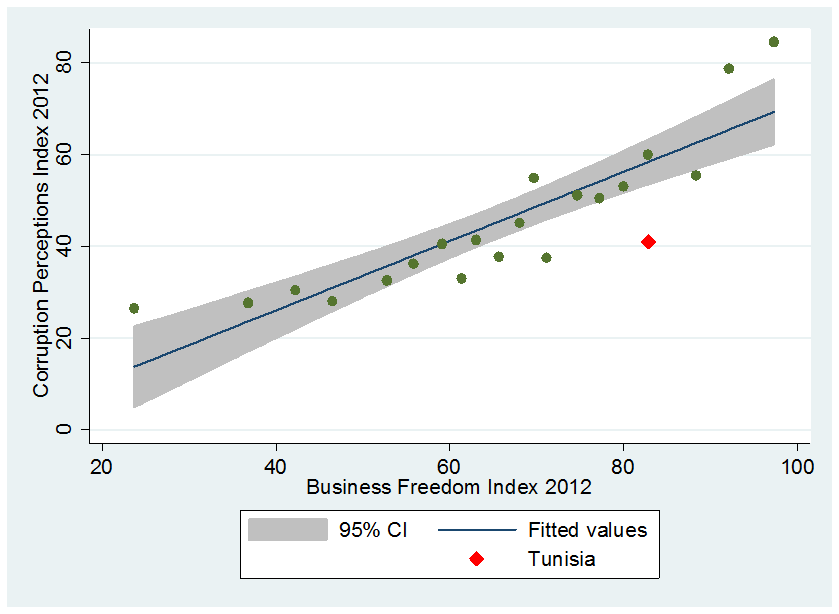In this chart of the week we examine the relationship between business freedom and corruption. Both concepts are subject to a wide range of studies and intensive debates seeing their impact on the economic, social and political aspects of a given society. They have been quantitatively captured through two indices developed respectively by the Heritage Foundation and Transparency International non-governmental organizations. In fact, the heritage foundation has introduced, in cooperation with the Wall Street Journal and since 1995, the Business Freedom Index (BFI), a component of its global Index of Economic Freedom that covers 10 freedoms including the BFI. The higher the BFI, the easier the task of creating, operating and closing businesses.
On the other hand, Transparency International has first launched the Corruption Perceptions Index (CPI) in 1995. The CPI focuses on the level of corruption in the public sector in each country by conducting sentiment analysis based on a periodic survey of informed analysts, businesspeople and experts in countries around the world. An economy with high CPI value is a clean economy with low corruption level.
Intuitively, it is expected that the burden put on business making through regulations and governmental intervention increases the likelihood of corrupt public sector, and leads to an opaque environment where fraudulent, unlawful and unethical behavior can easily emerge. In other words, the ability to start and operate a business conditions the level of corruption the public sector may suffer from.
This intuition is indeed confirmed by the chart displayed in the above. The figure clearly exhibits a positive correlation ( a correlation coefficient of 88.89%) between the BFI and CPI. In particular, we conduct our analysis based on a relatively large dataset comprising 145 countries. For both indices, we consider 2012 data. The BFI is binned into quintiles (20 buckets of equal mass, 5% of the total sample in each bin which explains why the chart displays 20 points only), to which the corresponding average CPI is computed.
While this assumption and intuition is being confirmed at large and all along the scatter plot in the given chart, we still can identify cases that slightly deviate from the hypothesis. As a matter of fact, the first bucket (with the lowest average BFI) is exhibiting a CPI comparable to its three neighbors (from the right). This CPI value (26.42) is mainly driven by Cuba's CPI (48) with BFI of only 10, which is not surprising for a communist regime where all business related matters are controlled by the central government. However, these mild fluctuations do not violate the apparent global positive linear correlation between the two indices. They could be perceived as instantaneous discrepancies preceding the underlying equilibrium between CPI and BFI.
Tunisia belongs to the bucket of countries number 17 (the fourth from the right) that is formed by Cyprus, Japan, Mexico, Tunisia, Portugal, France and Saint Lucia. It is clear from the chart that the average CPI of this bin is lower than its neighbor bin from the left (with lower BFI). A closer look inside this group of countries reveals that the CPIs of both Tunisia (41) and Mexico (34) are what is pulling down the overall CPI of the group (60). With a CPI of 41, Tunisia is ranked 68/145. Its BFI is 82.9 ranking it 35/145. This shows that despite the acceptable business freedom level, an economy may still be perceived as contaminated by some level of corruption. This could be comfortably explained by the fact that a period of one year of post-revolution is not enough to wipe out the corruption that contaminated the Tunisian public sector for decades, and against which the nation has revolted. This signals that Tunisia is most likely in the transitory regime of the dynamic between CPI and BFI and may reach the equilibrium in the future. Such claim needs a confirmatory analysis that digs into the pre-revolution period by examining the indices time series.
Oualid Missaoui, Tuness Research Team
Data source: Heritage Foundation and Transparency International

